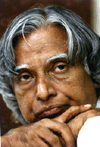'India's Missile Man', Avul Pakir Jainulabdeen Abdul Kalam has done the country proud on many fronts.
Born on 15 October 1931 at Dhanushkodi in the Rameswaram district of Tamil Nadu, Abdul Kalam's father had to rent boats out to fishermen to pay this genius' school fees. He received secondary education at the Schwartz School, a missionary institute in Ramanathapuram, and later joined the St Joseph's College at Tiruchirrapalli, where he graduated with a Bachelor in Science. Abdul Kalam went on to study Aeronautical Engineering at the Madras Institute of Technology.
"Do things yourself. Do not indulge in short-cuts by importing equipment", thundered the great scientist after the famed Pokhran-2 nuclear blasts in 1998. A strong advocate of this philosophy, he distributed newspapers at a young age to help with household expenses.
Thoroughly Indian, the only brief exposure that he got abroad was in 1963-64 when he was invited by NASA (National Aeronautics and Space Administration) to spend four months in the United States at the Wallops Island Rocketry Centre and the Langley Research Centre.
Abdul Kalam joined the Defence Research and Development Organisation (DRDO) in 1958 and in his forty-year career as a scientist, achieved many milestones. He later joined the ISRO (Indian Space Research Organisation) where he succeeded in putting the 35-kg Rohini-I satellite on a low-earth orbit with help of the SLV-III (Satellite Launch Vehicle). After spending 19 fruitful years in ISRO, he returned to DRDO to head the country's Integrated Missile Development Programme, which culminated in the successful launch of the Agni and Prithvi missiles.
Born on 15 October 1931 at Dhanushkodi in the Rameswaram district of Tamil Nadu, Abdul Kalam's father had to rent boats out to fishermen to pay this genius' school fees. He received secondary education at the Schwartz School, a missionary institute in Ramanathapuram, and later joined the St Joseph's College at Tiruchirrapalli, where he graduated with a Bachelor in Science. Abdul Kalam went on to study Aeronautical Engineering at the Madras Institute of Technology.
"Do things yourself. Do not indulge in short-cuts by importing equipment", thundered the great scientist after the famed Pokhran-2 nuclear blasts in 1998. A strong advocate of this philosophy, he distributed newspapers at a young age to help with household expenses.
Thoroughly Indian, the only brief exposure that he got abroad was in 1963-64 when he was invited by NASA (National Aeronautics and Space Administration) to spend four months in the United States at the Wallops Island Rocketry Centre and the Langley Research Centre.
Abdul Kalam joined the Defence Research and Development Organisation (DRDO) in 1958 and in his forty-year career as a scientist, achieved many milestones. He later joined the ISRO (Indian Space Research Organisation) where he succeeded in putting the 35-kg Rohini-I satellite on a low-earth orbit with help of the SLV-III (Satellite Launch Vehicle). After spending 19 fruitful years in ISRO, he returned to DRDO to head the country's Integrated Missile Development Programme, which culminated in the successful launch of the Agni and Prithvi missiles.

No comments:
Post a Comment